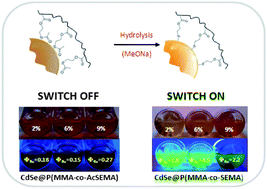Acetyl protected thiol methacrylic polymers as effective ligands to keep quantum dots in luminescent standby mode†
Abstract
Herein, we report evidence for the promising potential of 2-(acetylthio)ethylmethacrytale (AcSEMA), a new monomer, which copolymerizes with methyl methacrylate (MMA) by atom transfer radical polymerization (ATRP) leading to well-defined multidentate protected thiol polymer ligands for CdSe QDs capping by simple ligand exchange. Among the different strategies that can be employed for coating QDs, it is found that thioacetylated polymers, in the presence of hydrophobic QDs, are able to replace trioctylphosphine oxide (TOPO) ligands, leading to hybrid CdSe@PMMA nanoparticles without covalent binding of the polymer to the QD surface. These polymer protected QDs exhibit high stability for long periods of time, in a low luminescence standby mode. Moreover, the fluorescence QD activation of these hybrids is easily achieved at any time from thioacetate hydrolysis to free thiol under mild conditions. This subsequent step, which results in the covalent attachment of PMMA thiol groups to the metallic QD surface, produces compact QDs which exhibit amazingly improved photophysical properties, yielding highly photoluminescent new hybrid materials. For comparison, the same procedure was applied to obtain brush-like QDs coated with PMMA obtained by ATRP with a final thioacetate group. It was then established that the multidentate thiolated polymers provide additional protection against external quenchers, such as 4-amino-TEMPO, to a greater extent than the brush-like PMMA coating and the pristine TOPO capping ligand.


 Please wait while we load your content...
Please wait while we load your content...